Welcome to the latest edition of my annual Year in Bedlam movie round-up. As in the previous YiBs, you’ll find the movies of ’18—theatrical, straight to DVD/pay-per-view and, this being 2018, made-for-Netflix—grouped into Best and Worst categories. You’ll also find that, unlike my older Year in Horror overviews, I’ve opened this one up to films outside the horror-verse. In fact, I’ve cut back a bit on the scary stuff this time around (because, frankly, most of it is crap).
Other films I missed in 2018 included all the kid-friendly cartoon releases (not my thing) and, BLACK PANTHER and DEADPOOL 2 aside, the superhero flicks (on which I’m burnt out). Otherwise, though, I feel the following represents a good selection of 2018’s films, encompassing big studio, independent and foreign releases, and starting with my favorite of the lot, a choice that surprised me as much it probably will you…
The Best
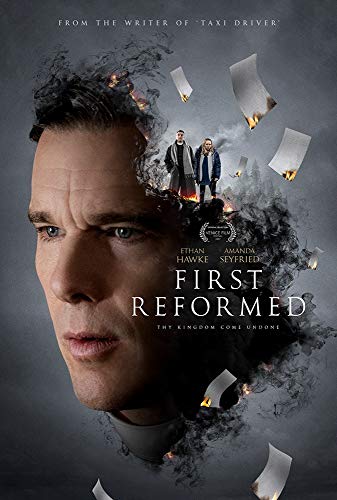 1. FIRST REFORMED
1. FIRST REFORMED
In this film from writer-director Paul Schrader, a sacramental thriller based on the “transcendental” cinema that inspired him (as detailed in the book TRANSCENDENTAL STYLE IN FILM), Schrader has created one of his greatest-ever films. Ethan Hawke stars as a tormented middle-aged priest whose problems, engendered by a bitter divorce and a son killed in action, are multiplied after a young pregnant woman (Amanda Seyfried) asks him to counsel her eco-warrior husband (Philip Ettinger). The latter is suicidal and possibly dangerous, yet his environmental concerns are quite alluring to Hawke, who in the midst of his crisis of faith latches onto Ettinger’s cause like the proverbial port in the storm. Those who think they know Schrader’s signature style will be surprised by this film, which with its ultra-spare visuals packed into an economical 1:33 aspect (i.e. non-widescreen) ratio and highly deliberate pacing plays like the films of the European and Asian masters (Bresson, Dreyer, Tarkovsky, etc.) who defined the transcendental aesthetic, while also harkening back to Schrader’s TAXI DRIVER script in its overall structure. For those willing to brave its resolutely non-commercial rhythms FIRST REFORMED is mesmerizing, being a fully assured piece of filmmaking with a spiritual outlook that’s notably complex. It may seem an unlikely concoction—a secular Travis Bickle, played by Ethan Hawke in a heavily religious milieu—but it works smashingly well, with a career-best performance by Hawke and excellent supporting work by Seyfried and, in a rare non-comedic turn as the head of Hawke’s church, Cedric the Entertainer.
2. THE BALLARD OF BUSTER SCRUGGS
It’s great to see Joel and Ethan Coen, after a string of duds, back in fighting form with THE BALLARD OF BUSTER SCRUGGS. Made for Netflix, it’s as stylish, twisted, archly funny and defiantly original as anything the Coens have ever done. The Tim Blake Nelson played title character is a shootist-crooner who can out-sing everyone around him and best any man with a gun—until, unexpectedly enough, he doesn’t. From there the film segues to another tale set in the same hard-bitten western milieu, featuring James Franco as a bank robber in over his head, and from there to another story involving Liam Neeson as the corrupt proprietor of a travelling sideshow…and so on. It’s no exaggeration to call this one of the absolute best looking Coen films, with lyrical cinematography by Bruno Delbonnel that’s worthy of being frozen and placed inside picture frames while still conveying the unforgiving grit and brutality of the Old West. This is a relentlessly brutal film, with the stories all ending in some horrifically violent happening that keeps us constantly on edge, and so adequately sets the tone for each succeeding tale. The comedic aspects register just as strongly, of course, leaving us with a concoction that’s pure Coen through and through.
3. A QUIET PLACE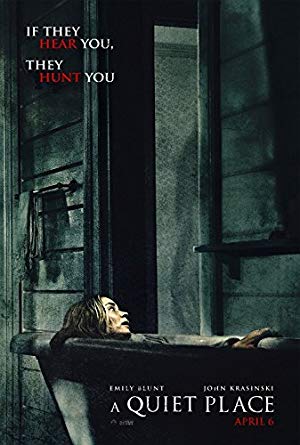
An impressive exercise in something that heretofore has been a bit of a rarity: sound based horror. A QUIET PLACE is set in a world ravaged by monsters that kill anything that makes a sound, forcing the sole human survivors, played by the film’s writer-director John Krasinski and his real-life spouse Emily Blunt, to be as quiet as they can. The nature of the film ensures that the audience is kept highly attuned to the sound design, and Krasinski and his collaborators accomplish that design, and virtually everything else, with consumate skill. They also succeed in mostly keeping the proceedings on the edge of plausibility, although that aspect collapses entirely in the final third, after Blunt gives birth to the world’s quietest baby (which the critters somehow don’t hear). The CGI monsters, at least, are unique and imposing creations, which by itself goes a long way toward making the film palatable.
4. MANDY
Those who’ve seen writer-director Panos Cosmatos’ previous film BEYOND THE BLACK RAINBOW will know what to expect from this one: a dreamy, psychedelic riff on any number of traditional horror and exploitation movie tropes that all-but flaunts the minimalism of its narrative. That Cosmatos has such a strong grasp of otherworldly tone and atmosphere is a good thing, as without them MANDY would add up to very little. It features Nicolas Cage as the loving husband of the title character (Andrea Riseborough), who is burned to death by a band of religious nuts in the Pacific Northwest (actually Belgium). The religiosos, led by a maniacal Linus Roache, make the mistake of not killing Cage, who borrows some heavy-duty weaponry from pal Bill Duke and hits the revenge trail. A fine splatterific blow out follows that despite its relentlessness never loses the ethereal charge of the earlier scenes.
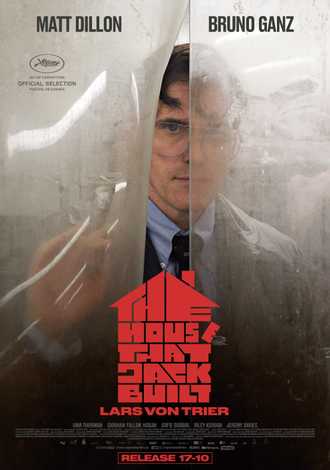 5. THE HOUSE THAT JACK BUILT
5. THE HOUSE THAT JACK BUILT
This film, a serial killer drama by Lars von Trier, received some of the most venomous reviews of 2018, with exclamations of extreme outrage and accusations of the participating actors being “complicit.” I can only imagine how those critics might react to ANGST, HENRY: PORTRAIT OF A SERIAL KILLER or MAN BITES DOG—or for that matter von Trier’s own 2009 freak-out ANTICHRIST, which far outdoes this one in every respect. Nonetheless, I say THE HOUSE THAT JACK BUILT is von Trier’s best film in some time, an irascibly confrontational provocation with a satiric thrust. That latter element appears to have been entirely lost on most critics, yet it’s one of the film’s primary virtues, being directed at horror cinema in general and von Trier himself. His penchant for intellectualizing his material to death is taken to hysterical lengths here, as the Matt Damon essayed protagonist is a rabid intellectual who views his bloody business as a work of art—which he reveals via extensive voice-over conversations with Bruno Ganz as a sort of (arch)angel of death, during which William Blake, Goethe and a ton of other smart people topics are discussed. But as with ANTICHRIST, the film’s ultimate pleasure is the same as that of most Lucio Fulci movies: it’s completely and sublimely insane from start to finish. This is evident in the many ultra-quirky details that only Von Trier could possibly have dreamt up, such as the wholly outrageous way Dillon makes off with a freshly killed corpse when a pesky cop comes sniffing around and the titular “house” he builds in a most unexpected climax. Dillon is quite strong in the lead role, directly recalling the many miscreant roles he’s played over the years (Jack isn’t that far removed from MY BODYGUARD’S Melvin Moody or THERE’S SOMETHING ABOUT MARY’S Healy), and the supporting cast is filled out with a number of reliable talents (Uma Thurman and Riley Keough among them). The overriding flaw? At two and a half hours the film is simply TOO DAMN LONG!
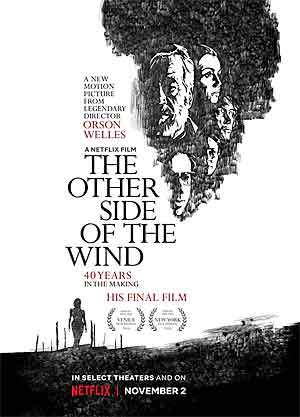 6. THE OTHER SIDE OF THE WIND
6. THE OTHER SIDE OF THE WIND
Here we have a rather profound cinematic event: the long awaited completion of Orson Welles’ final film, shot back in the 1970s but left unfinished until 2017, when Netflix managed to secure the rights (certainly no easy feat, as has been proven repeatedly over the decades) and enlisted two of the film’s principal participants, Peter Bogdonovich and Frank Marshall, to help piece it together. The result is, frankly, a mess, marred by poor sound recording, uneven performances and choppy editing. But THE OTHER SIDE OF THE WIND is also graced with its creator’s visual genius, and pulled off with an energy that belies the fact that Welles was an old fart when it was made. The story, such as it is, involves a faux-documentary investigation of an aging film director (John Huston) and his fraught relationship with a young protégée (Bogdonovich). The real life subtext is pretty obvious, with Huston portraying a thinly fictionalized variant on Orson Welles, and Bogdonovich, who had a relationship with Welles that was easily as complicated as the one depicted here, essentially playing himself. A great deal of the film feels redundant; among other things, there are too damn many party scenes, seemingly included to showcase Welles’ famous friends (Dennis Hopper, Paul Mazursky, Stephane Audran, etc.). But the bravura and ingenuity of the filmmaking is undeniable, and undeniably dazzling. A full success this film is not, but it is a fascinating hodgepodge.
7. MISSION: IMPOSSIBLE—FALLOUT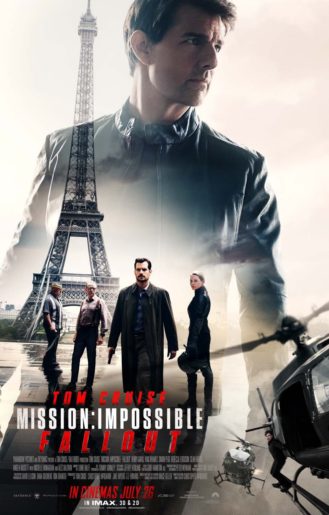
The latest entry in the seemingly never-ending MISSION: IMPOSSIBLE franchise once again finds Tom Cruise running, fighting and performing a plethora of death-defying stunts in exotic European locales. Also back are Vingo Rhames, Simon Pegg and the ever-fetching Rebecca Ferguson as Cruise’s action-mates, and Michelle Monaghan as his long-suffering wife. There’s a story, but it’s impossible to follow and, as always, takes a backseat to the action sequences, which are suitably elaborate and diverting. As he proved in the last MISSION movie, writer-director Christopher McQuarrie has a definite knack for this sort of thing, and has turned out what may be the best film of the franchise—even if the non-action scenes tend to fall flat, and the climax, involving a helicopter duel and a fight to the death on some extremely steep cliffs, is a mite over the top even by traditional Hollywood action movie standards.
8. CREED II
This is very likely the finest ROCKY sequel ever made, but CREED II still has its share of inherent problems. This is to say that director Steven Caple, Jr. does an excellent job juggling a myriad of characters and subplots with a great deal of energy and inspiration, but can’t overcome the fact that he’s following up ROCKY IV, arguably the goofiest of the ROCKY flicks. In that film, as you may recall, Rocky (Sly Stallone) travelled to Russia to take on Ivan Drago (Dolph Lundgren) after the latter killed his friend and former rival Apollo Creed in the ring. Caple treats this material like high drama, providing a sober and non-ironic depiction of what happened to Rocky, Drago and the latter’s estranged wife (Brigitte Neilson) after the end of ROCKY IV (when Rocky managed to win over a Soviet crowd and single-handedly end the Cold War). Drago has become an embittered recluse training his son Viktor (Florian “Big Nasty” Munteanu) to take on Apollo’s son Adonis (Michael B. Jordan) in the ring, just as Adonis’ wife (Tessa Thompson) becomes pregnant and his trainer Rocky thinks—again—about retiring. You can probably guess how it all goes down from there.
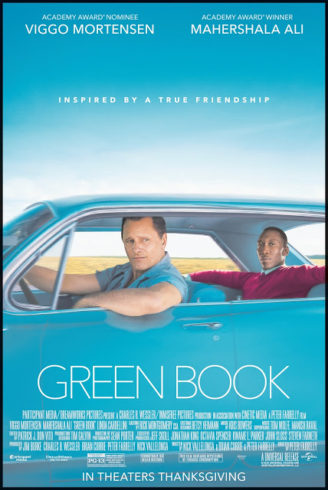 9. GREEN BOOK
9. GREEN BOOK
A film that’s impossible not to like at least partially. It’s the based-on-fact account of a brutish Italian-American bouncer (Viggo Mortensen) tasked with driving the black pianist Don Shirley (Mahershala Ali) through America’s Deep South in the early 1960s, guided by the titular Green Book highlighting black people-friendly hotels and eateries.
Both characters, as you might guess, are indelibly impacted by the journey, with Mortensen coming to appreciate Ali’s skill and refinement—and also the struggles faced by African Americans—just as Ali learns to be more relaxed. Both actors evince genuine unforced chemistry, and director Peter Farrelly (formerly of the Farrelly brothers) furthers the easygoing vibe with relaxed and unshowy filmmaking, making for a rare message movie that never feels labored or insistent.
10. ROMA
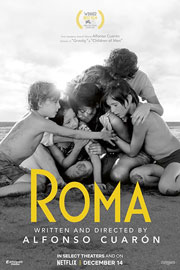 A film that was evidently made expressly for film nerds, which explains why I couldn’t help but appreciate it. Lensed in stunningly evocative black and white with incredibly dense, textured imagery, it’s a visual stunner tailor-made for the big screen; how ironic, then, that ROMA is a Netflix production, and so destined to be experienced by most viewers on TV sets. I’m among those viewers, which may explain why I wasn’t as enamored with ROMA as everyone else appears to be. It’s an autobiographical reverie by writer-director-cinematographer Alfonso Cuaron, who provides a highly episodic depiction of his childhood in early 1970s Mexico, dominated by a stern patriarch (Fernando Gediaga), his gruff but loving wife (Marina de Tavira) and their long-suffering maid (Yalitza Aparicio), who has to deal with her employers’ constant mood swings as well as an asshole boyfriend and a stillbirth. Dramatically the film fails to match its visuals, an inevitability given that the heroine is so resolutely silent and stoic throughout. Aparicio is quite good at conveying emotion through looks and gestures, but she’s not given enough to do, with her major heroic act, consisting of rescuing her employers’ children from drowning in what looks to be about two feet of water, being rather unconvincing.
A film that was evidently made expressly for film nerds, which explains why I couldn’t help but appreciate it. Lensed in stunningly evocative black and white with incredibly dense, textured imagery, it’s a visual stunner tailor-made for the big screen; how ironic, then, that ROMA is a Netflix production, and so destined to be experienced by most viewers on TV sets. I’m among those viewers, which may explain why I wasn’t as enamored with ROMA as everyone else appears to be. It’s an autobiographical reverie by writer-director-cinematographer Alfonso Cuaron, who provides a highly episodic depiction of his childhood in early 1970s Mexico, dominated by a stern patriarch (Fernando Gediaga), his gruff but loving wife (Marina de Tavira) and their long-suffering maid (Yalitza Aparicio), who has to deal with her employers’ constant mood swings as well as an asshole boyfriend and a stillbirth. Dramatically the film fails to match its visuals, an inevitability given that the heroine is so resolutely silent and stoic throughout. Aparicio is quite good at conveying emotion through looks and gestures, but she’s not given enough to do, with her major heroic act, consisting of rescuing her employers’ children from drowning in what looks to be about two feet of water, being rather unconvincing.
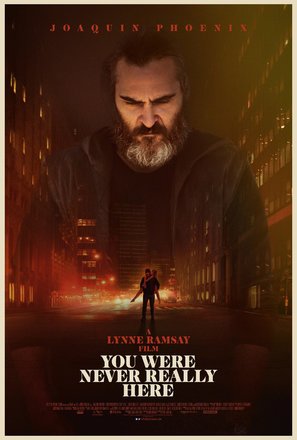 11. YOU WERE NEVER REALLY HERE
11. YOU WERE NEVER REALLY HERE
A film that closely recalls the arthouse “thrillers” of Claire Denis (I CAN’T SLEEP, TROUBLE EVERY DAY, etc.), as well as the previous filmography of its artier-than-thou writer-director Lynne Ramsay (MORVERN CALLAR, WE NEED TO TALK ABOUT KEVIN) far more than the “TAXI DRIVER for a new century” that was promised. At once languid and uneventful yet also quite pointed and intense in its approach, YOU WERE NEVER REALLY HERE centers on Joaquin Phoenix as a traumatized war veteran turned vigilante detective. His latest job involves the rescue of a young girl from a big city pedophile ring, but after freeing the girl things go haywire, resulting in a succession of events that may or may not be an extended hallucination in the deteriorating mind of the protagonist. The film’s artiness can be suffocating, but the beauty of the cinematography by Tom Townend and Phoenix’s committed performance are mesmerizing. There’s also a great deal of graphic brutality that probably won’t appeal to arthouse viewers, making for a neither-here-nor-there oddity.
12. ANNIHILATION
A loose adaptation of the Jeff Vandermeer novel ANNIHILATION. The film is only partially successful but deserves to be seen, as in terms of color, nuance and sheer ambition it ranks pretty high. It concerns a region of the American South cut off from the rest of the country after a meteorite crashes there and transforms the area into an alien landscape. A rather stiff and unsympathetic Nathalie Portman plays a scientist whose husband (Oscar Isaac) was part of a disastrous expedition into the area. She signs up for a new expedition, along with four other women (Jennifer Jason Leigh and Gina Rodriguez among them), leading to confrontations with mutated creatures and a close encounter with an unknowable alien intelligence. The writer and director was Alex Garland, following up the impressive android thriller EX MACHINA. He displays a similar amount of sci fi razzle dazzle here, providing a rigorously conceived visual phantasmagoria that unfortunately has a rather chintzy, artificial look to it. Blame cinematographer Rob Hardy, or perhaps Garland’s overuse of CGI, which isn’t nearly as impressive as was evidently intended (particularly in the hallucinogenic 2001: A SPACE ODYSSEY-esque climax, in which the imagery all-but shouts out how awe-inspiring it’s supposed to be). What saves the film is the layered and intricate sound design, an area in which Garland really excels. For this reason ANNIHILATION is best experienced on a big screen, but very few moviegoers, it seems, bothered to make the effort.
13. DEATH WISH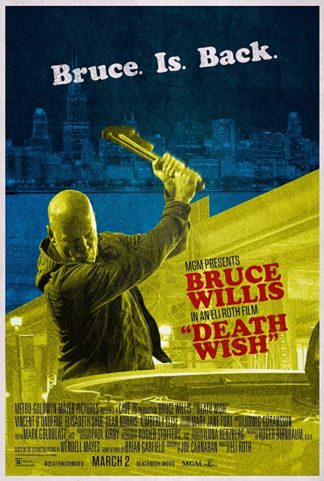
Nothing too deep or profound here, but this movie works, pure and simple. It’s a remake of 1974’s DEATH WISH, with Bruce Willis assuming the Charles Bronson role of a non-violent family man turned remorseless vigilante after his wife is killed and his teenage daughter rendered comatose by a gang of scumbags. In the original film the scumbags’ attack involved a truly vile gang rape (perpetrated in part by a young Jeff Goldblum), but here the attack occurs during a robbery gone wrong, which is staged like something out of a horror movie. That latter aspect shouldn’t surprise anyone, as the director was Eli Roth, who utilizes his penchant for horrific nastiness to great effect; standout bits include a torture sequence involving motor oil poured into an open wound and a close-up of a bad guy’s neck breaking as he’s thrown to the ground, both vintage Eli Roth moments. Dramatically Roth is decidedly less assured, as is evident in the uncertain tone (which often grows distractingly melodramatic) and frequent bad acting by the supporting cast. But the original DEATH WISH and its sequels, let’s not forget, weren’t cinematic masterpieces by any means yet did their job adequately. The same can be said for this one.
14. CANIBA
You simply will not find a more disturbing documentary than 2017’s CANIBA, which takes an up-close and very personal look at the infamous Japanese cannibal-murderer Issei Sagawa. On June 11, 1981, while studying in Paris, Issei murdered 25 year old Renee Hartevelt and cannibalized her corpse; Sagawa was arrested for the crime, only to be let free by reason of insanity and sent back to Japan. Since then he’s used the notoriety of his crime to make money while living with his brother Jun. It’s in the latter’s house, the layout and furnishings of which are kept indistinct, that this film takes place. As directed by Lucien Castaing-Taylor and Verena Paravel (of LEVIATHAN and SOMNILOQUIES), CANIBA proceeds in extreme (and often out of focus) close-ups of Sagawa, a vacant-eyed and downright creepy personage who looks every bit the monster he is. The film’s most upsetting scene, unexpectedly enough, involves Jun, who in the film’s final third takes center stage to set up a kind of barbed wire torture device, designed to inflict as much pain as possible—on himself! Intimate though the film is in its depiction of Sagawa’s proclivities, the pitiless examination of the masochistic fetishes of his brother portends that the type of psychosis that drives Sagawa isn’t nearly as isolated as it might seem.
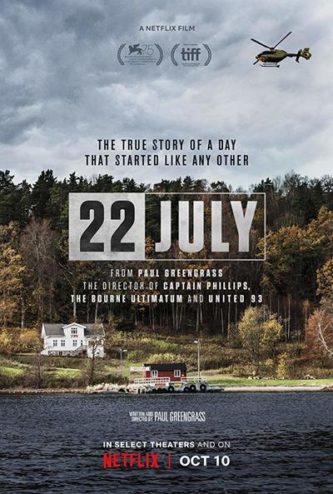 15. 22 JULY
15. 22 JULY
Here writer-director Paul Greengrass follows the template of his previous films BLOODY SUNDAY, UNITED 93 and CAPTAIN PHILLIPS, all resolutely literal-minded recreations of real-life tragedies. In 22 JULY Greengrass dramatizes the 2011 terrorist attack that occurred on an island in Norway, in which 77 people were murdered by right wing nut-job Anders Behring Breivik. Sounds like material that’s tailor-made for Greengrass’ talents, but here he runs directly into a problem he managed to avoid in his earlier films: that of commonplace sentimentality. This is inevitable given the way Greengrass structures the film, with the massacre dispensed with in the opening thirty minutes and the remaining two hours taken up with the struggles of a survivor (Jonas Strand Gravli) to readjust to life, and also those of the lawyer (Jon Øigarden) charged with defending Breivik. There’s lots of TV movie-friendly crying scenes and fumbling attempts at putting the tragedy into some kind of context, although those things don’t negate the towering performance of Anders Danielsen Lie as Breivik, nor the power of Greengrass’ unerringly naturalistic staging. Many critics have naturally taken Greengrass to task for his commitment to realism, dubbing the film “exploitive,” when I’d say it’s as tasteful in its presentation of this horrific account as it could possibly be.
16. READY PLAYER ONE
Here we have a movie that, in a very rare occurrence, actually improves upon its source novel. That novel was READY PLAYER ONE by Ernest Cline, which became a pop-cultural phenomenon despite the fact that it’s not all that great. This Steven Spielberg directed adaptation retains many of the things that made the book such an annoyance (the incessant references to eighties-era pop culture first and foremost), but succeeds in morphing Cline’s painfully knowing and ironic screed into an exciting popcorn movie spectacle. Set in a future America where everyone is obsessed for some reason with the 1980s (Spielberg extends Cline’s pop culture scope to encompass the seventies and nineties), the film takes place largely inside the Oasis, a virtual reality emporium whose users are rendered as cartoon avatars amid elaborate computerized landscapes. The protagonist is a young punk (Tye Sheridan) who joins a competition to get ahold of the fortune of the Oasis’s deceased creator (Mark Rylance) via a competition whose participants include the minions of an asshole businessman (Ben Mendelsohn) looking to corporatize the Oasis. I wouldn’t dream of telling you who wins the contest, nor the outcome of the relationship that develops between Sheridan and a hot chick avatar (Olivia Cooke) who shockingly enough also turns out to be a hot chick in real life (albeit with a semi-noticeable facial birthmark, which renders her a freak by Hollywood standards). Their virtual reality exploits make for great fun, enhanced by Spielberg’s expert intercutting between the real and virtual worlds to show what the characters are doing in each.
17. BLACK PANTHER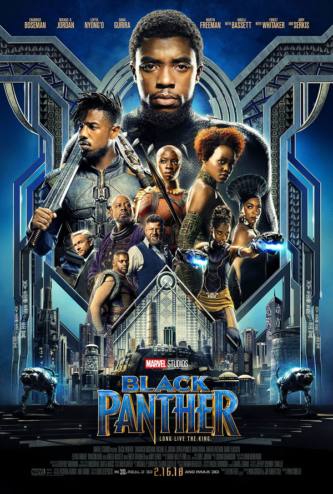
This is a film that, given its pedigree as the first-ever all black Marvel movie, you simply have to like. That’s evident in the absurdly over-enthusiastic reviews BLACK PANTHER has been getting (with comparisons made to Booker T. Washington, W.E.B. Du Bois and William Shakespeare), and the fact that the Academy of Motion Picture Arts and Sciences nearly created a new Best Picture category just to ensure it was nominated. Luckily I enjoyed the film, albeit not as much as every other critic apparently did. It takes some time to get going, with the focus in the early scenes divided between the title character and his women family members, but once the narrative finds its footing it becomes quite compelling. Director Ryan Coogler forgoes the traditional superhero movie structure (the Black Panther doesn’t bother saving too many civilians) in favor of a complex family saga that takes place largely in a futuristic African milieu. Coogler pulls off some elaborate and audacious action sequences within that setting, and some striking imagery—although I’d have preferred a grittier texture than the plainly unreal CGI wonderland Coogler provides.
18. FIRST MAN
For this film, a dramatization of the 1969 Neil Armstrong moon landing, director Damien Chazelle goes the full-immersion route—with mixed results. Certainly the film contains some hair-raising sequences, with special attention paid to the minutiae of the many tiny simulators and capsules into which Armstrong (Ryan Gosling) is constantly being packed—and which more often than not end up spinning horrifically out of control. The problem is with the visual style Chazelle utilizes, which is the polar opposite of the intricately choreographed wide shots of his previous effort LA-LA LAND (in which nearly every scene looked the same); here he employs a series of hand-held close-ups, which are, frankly, a bitch to watch, particularly in the film’s intended big screen format. Another issue I have is with all the clichés, from the long-suffering wife character (Claire Foy) who continually interrupts the action (the parts of the movie when everyone in the theater checks their cell phones) to the dead relative subplot that it seems every space-themed film has to have these days (however true to life that subplot may be). Offsetting the bad things are the rich, lived-in period detail and the excitement of the climactic moon landing, pulled off with actual audio from the event and a camera that for once stays still.
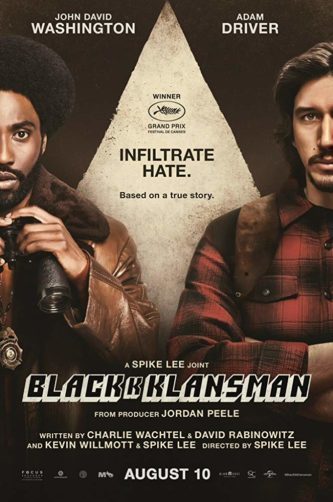 19. BLACKKKLANSMAN
19. BLACKKKLANSMAN
This film, as was the case with quite a few 2018 releases, was vastly overpraised by critics who were evidently more enamored with its political convictions than its achievement. It’s a Spike Lee “joint” with all the annoyances Lee’s joints tend to have, namely a sledgehammer bluntness that makes most Oliver Stone movies look restrained and a severely overstuffed and often disjointed narrative. Outside those things BLACKKKLANSMAN is pretty good, being the little-known fact-based account of a black police detective (John David Washington) infiltrating the Ku Klux Clan in early-1970s Colorado Springs, CO by getting in touch with the local Klan chapter via phone and then sending a white colleague (Adam Driver) to meet with them. The proceedings are quite gripping and darkly comedic, bolstered by an excellent performance by Washington, who brings a great deal of the fire and charisma of his father Denzel. But Lee insists on throwing in a lot of extraneous elements, such as a swipe at D.W. Griffith (a deserving target, certainly, but one that belongs in a different movie) and footage from the 2017 unrest in Charlottesville, VA, apparently to make absolutely sure we fully understand this film’s modern-day parallels.
20. CRAZY RICH ASIANS
A film that blew many peoples’ minds simply because, it seems, its cast is entirely made up of Asians. To those of us who see Asian films, however (for the thousandth time: if you don’t like what Hollywood is offering there are alternatives!), that aspect didn’t seem too surprising, leaving a film that’s merely okay. CRAZY RICH ASIANS is also credited with reigniting the long-dormant Hollywood rom-com trope, and as in most rom-coms the lead character is a cute cypher, with a rich and quirky supporting cast doing all the heavy lifting. Constance Wu plays said protagonist, a perky college professor who travels to Singapore with her hunky BF (Nick Young) to meet his family, who turn out to be richer-than-God eccentrics (among them Michelle Yeoh, Gemma Chan and THE HANGOVER’S always watchable Ken Jeong). Visually this film is a mighty pleasing concoction, boasting one of the most attractive casts in recent memory and a wealth of eye-catching scenery, particularly in the climactic wedding, in which fake reeds, water and exotic flora come into play.
21. RED SPARROW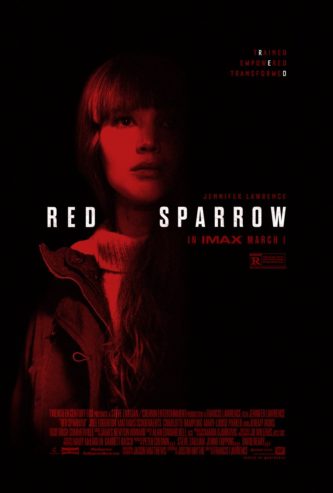
A film that was ill-served by its publicity campaign, which failed to convey the intense R-rated thriller it happens to be, and also by its director Francis Lawrence (of the final three HUNGER GAMES movies), who’s far from the ideal choice for such fare. Jennifer Lawrence, at least, is quite engaging as a young Russian woman who’s inducted into a government-run program in which she’s taught how to use her body to ferret out an American spy. This entails nudity, gore and torture (although, this being 2018, people were naturally most offended by an apparently sexist photo call in London) amid a convoluted and only sporadically involving narrative. The supporting cast includes distinguished names like Charlotte Rampling, Mary-Louise Parker and Jeremy Irons, who fail to elevate the film much beyond the mildly entertaining level. It’s perfectly okay for what it is, but never exceptional.
Recommended DVD Releases
THE ATOMIC CAFÉ
An alternately funny and horrifying documentary about the atomic age, decked out with interviews and vintage nuclear propaganda films.
THE BEAUTIFUL TROUBLEMAKER
Not the greatest movie ever made, but it’s worth seeing, if for no other reason than the sight of a young Emmanuelle Beart posing naked for nearly four hours!
BOUND
The first feature by the Wachowski siblings was this nifty neo-noir about a lesbian couple in over their heads, now available in an extras packed DVD/Blu-ray.
BREWSTER McCLOUD
A studio archive (meaning no extra features or digital remastering) version of one of Robert Altman’s wildest films. It’s better than nothing, I guess.
THE COLOR OF POMEGRANATES
Sergei Parajanov’s masterpiece gets Criterionized—need I say more?
CROSS OF IRON
Previous DVD releases of this Sam Peckinpah war movie classic left much to be desired in terms of picture and sound quality. Here’s hoping this new release from Hen’s Tooth Video rectifies those issues!
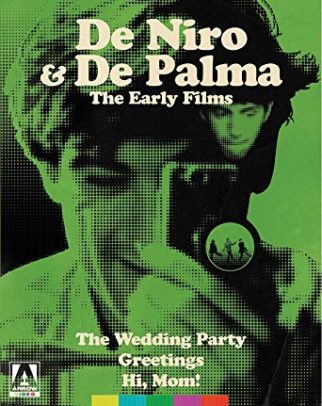 DE PALMA AND DE NIRO: THE EARLY FILMS
DE PALMA AND DE NIRO: THE EARLY FILMS
From the irrepressible Arrow Video, a box set of the Brian De Palma directed, Robert De Niro headlined late sixties flicks THE WEDDING PARTY, GREETINGS and HI MOM, the last of which qualifies as a must-see.
DEADBEAT AT DAWN
Arrow Video once again does its thing, providing an extras-packed take on Jim Van Bebber’s no-budget wonder from the eighties.
FORTY GUNS
One of the late Samuel Fuller’s most eccentric westerns gets the Criterion treatment, with a couple nifty documentaries and a can’t-be-bettered audiovisual package.
INVASION OF THE BODY SNATCHERS
A new DVD/Blu-ray release of the immortal Don Siegel classic that far outdoes any of the previous ones.
THE LAST MOVIE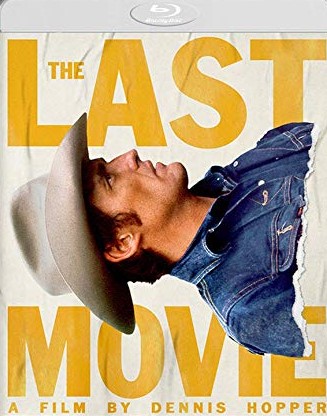
This was Dennis Hopper’s much-derided follow-up to EASY RIDER, and I say it’s deserving of a critical reassessment—hopefully this new Blu-ray release will help facilitate that!
THE LAST SEDUCTION
Not the first time this nineties noir has been released in digital format, but this 2018 release is the first with extra features (audio commentaries, etc.).
MAC AND ME
An absolute jaw-dropper from the 1980s—just see it!
MAD FOXES
This rather scrappy Full Moon release doesn’t seem like the definitive DVD version of this beyond-insane exploitation classic, but I say the fact that MAD FOXES is available at all is cause for celebration.
THE MAGNIFICENT AMBERSONS
Orson Welles’ butchered 1942 masterpiece, released in what is said to be its finest-ever image and sound quality.
A MATTER OF LIFE AND DEATH
A signature film by Michael Powell and Emeric Pressburger that for some reason took until 2018 to make it to DVD/Blu-Ray, courtesy of the Criterion Collection.
THE SACRIFICE
Not my favorite Andrei Tarkovsky film, but the mere fact that it’s a Tarkovsky film renders this, the second and more comprehensive US DVD release of THE SACRIFICE, a must-own.
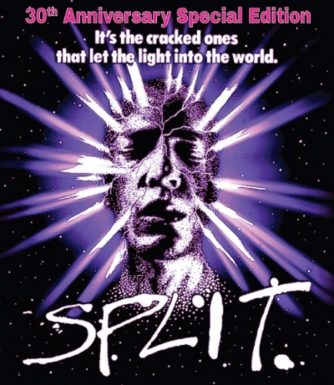 SPLIT
SPLIT
It’s taken a full three decades, but an extras-packed DVD release of this little known sci fi classic is here at last (FYI, this SPLIT is not to be confused with the similarly titled M. Night Shyamalan flick, which it appears is exactly what occurred on Amazon).
TRUE STORIES
A most worthy Criterion-ization of David Byrne’s terrifically quirky 1986 musical TRUE STORIES, which remains the best Jonathan Demme movie never made.
YOR—THE HUNTER FROM THE FUTURE
More eighties cheese, a Turkish-Italian co-production that somehow mixes sword-and-sandal and sci fi.
The Worst
1. FIFTY SHADES FREED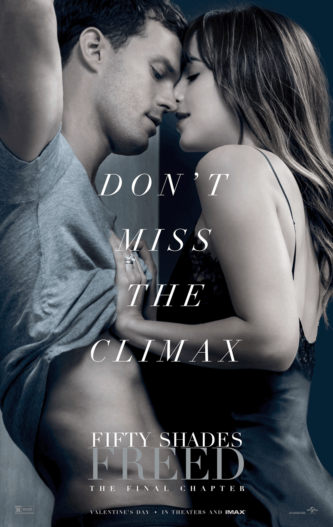
Here’s a surprise: this movie, the final entry in the FIFTY SHADES trilogy, sucks. It once again features Ana (Dakota Johnson) in thrall to her now-husband Christian (Jamie Dornan), whose kinky trysts result in her being impregnated (as she says at one point, “when you have sex babies tend to appear, and we’ve been doing a lot of that”) and threatened by her former boss Jack (Eric Johnson), who’s pissed that Christian got him fired. Thus the film becomes a thoroughly lackluster “thriller” that concludes in the least invigorating way imaginable. Add to that the total lack of chemistry between the leads and the utterly unerotic sex scenes (far more arousal is provided by director James Foley’s penchant for having Johnson and Dornan constantly taking their shirts off) and you’ve got…well, a FIFTY SHADES movie.
2. TOMB RAIDER
A dull, pointless reboot of a dull, pointless original. If the Angelina Jolie headlined LARA CROFT: TOMB RAIDER proved anything it’s that video games do not make for ideal movie material, and this new version only furthers that sentiment (see SUPER MARIO BROS, DOOM and the early-00s filmography of Uwe Boll for confirmation). The new lead is Alicia Vikander, who tries her best as Lara Croft (as Jolie did) and looks great (as Jolie did), but can’t overcome the mess of monotonous action movie clichés this film has in place of a script. There are endless slick but nonsensical CGI addled action sequences that by the end come to take on a distinctly NATIONAL TREASURE-esque feel. The problem is, in part, that most of the movie takes place in a single confined setting: a tropical island where Lara is looking for her long-lost father (Dominic West), leading to action that, curiously, grows progressively less involving as it advances.
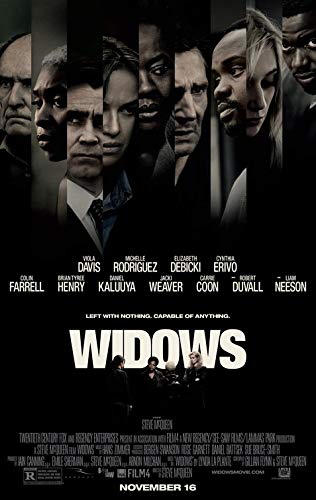 3. WIDOWS
3. WIDOWS
There’s a decent heist movie lurking somewhere in this boated awards grabber. About three women (Viola Davis, Michelle Rodriguez and Elizabeth Debicki) who’ve been screwed over by the mob pulling off an elaborate heist, it contains numerous opportunities for humor and suspense in the script by GONE GIRL’S Gillian Flynn, but director Steve McQueen’s heavy-handed approach makes for a dreary and immensely self-important slog of a film. McQueen makes sure to inject innumerable political points in the form of Colin Farrell as a corrupt politician whose speeches are often intercut with the action, and an overstuffed supporting cast that appears to have been intended to represent a cross-section of modern America (or something).
4. BOY ERASED
A message movie, with the two-fold message being 1). Homophobia is bad, and 2). Those “Pray away the gay” programs so beloved by the religious right don’t work—things I’m assuming most of us already know. Based on a true story, BOY ERASED is about an effeminate teenager (Lucas Hedges) sent to a gay reeducation camp by his ultra-religious parents (Nicole Kidman and Russell Crowe). The place, as you might guess, is far from hospitable, and nor do its gruff overseers do much to change the sexual orientation of their charges—as Hedges learns upon being nearly raped by his male roommate. The performances are strong, with the standout being not Nicole Kidman (around whom Oscar buzz has been swirling) but Russell Crowe, who’s both horrifying and moving as a fearful and ignorant yet also loving father.
5. MARY POPPINS RETURNS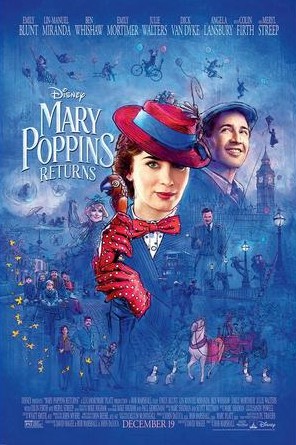
One thing—nay, the only thing—I’ll say in this movie’s favor is that it gave me a new appreciation for the original MARY POPPINS. That’s a film I haven’t thought about much in the forty or so years since I last viewed it, but I’m finding I remember much of its imagery and songs quite well—much better, in short, than anything in this sequel. About Mary P. returning to help out the now grown-up kids she previously looked after and their three children, it follows the MARY POPPINS template quite rigorously, with an episodic series of fantasy-musical numbers that often incorporate cartoon imagery. The film’s major problem is a miscast Emily Blunt as Poppins, who comes off as excessively haughty and distant, lacking the warmth and (for lack of a better word) magic that Julie Andrews brought to the role. Faring much better is Lin-Manuel Miranda as a friendly lamplighter—essentially a modern version of the Dick Van Dyke character from the original—who connects with the material far more strongly than Blunt. Speaking of Van Dyke, his brief appearance near the end is probably the best part of the entire movie, making one wish the filmmakers had trotted out Julie Andrews (old, infirm and probably senile though she may be) as well.
6. THE FIRST PURGE
More of the same from the PURGE-verse. This fourth entry is a prequel, showing what occurred during the first Purge, in which all illegal acts are made legal over the course of a single night. It’s an experiment, cooked up by America’s current ruling party the New Founding Fathers of America, and confined to Staten Island. As in the last couple PURGE films much of this one takes place in lower income areas, where a psychopathic junkie named Skeletor makes the night’s first killing; it won’t be the last, as the NFFA has sent hired mercenaries into the fray to stir things up. Director Gerard McMurray does a better job choreographing the copious action and bloodletting than James DeMonaco did in THE PURGE 2 and 3, but the material has grown so tired it’s hard to ever get too involved.
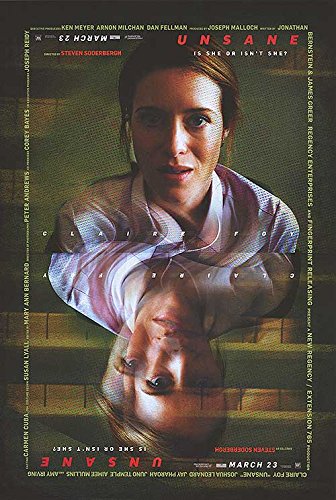 7. UNSANE
7. UNSANE
Director Steven Soderbergh’s latest attempt at a suspense thriller (following 2013’s SIDE EFFECTS, which I didn’t much like either) boasts the gimmick of having been shot entirely with an iPhone. Claire Foy stars as a young woman who’s involuntarily committed to a mental hospital, apparently by a nutty guy (THE BLAIR WITCH PROJECT’S Joshua Leonard) who’s been stalking her, and has somehow gotten himself employed in the place. We’re supposed to wonder if the conspiracy against Foy is real or just a product of her disturbed mind, but the whole thing seemed quite straightforward to me. There are none of the narrative red herrings you might expect, with the iPhone visuals, which tend to emphasize highly pointed and ordered compositions, meant to convey a sense of psychological disintegration (which they don’t). Another problem is with the heroine, who is so abrasive and downright obnoxious I often wondered if Soderbergh was attempting to make some kind of dark comedy (which apparently he wasn’t).
8. RAMPAGE
A good example of how a crappy last few minutes can ruin an entire movie. RAMPAGE is a cheerfully goofy Dwayne Johnson vehicle that sees DJ shepherding a gorilla that, due to a pathogen released from a blown-up space station, grows to King Kong size along with a wolf and an alligator. These three giant critters eventually face off in the streets of Chicago, causing lots of wholesale destruction. For most of its runtime I found the flick a perfectly acceptable time-waster, with a goodly amount of action (unlike 2014’s GODZILLA, RAMPAGE doesn’t waste time with character development or narrative nuance) and decent CGI effects. Again, it’s the last few minutes that, in the manner of the infamously misconceived curtain call sequence in THE BAD SEED and the obnoxious THIRTYSOMETHING-esque coda of ARACHNOPHOBIA, do the film in. I’m all for happy endings, but Hollywood really has to get over the he’s-dead-no-he-really-isn’t cliché, and the equally clichéd concluding shot of all the principals laughing that’s utilized (for the thousandth or so time) in RAMPAGE.
9. ON THE BASIS OF SEX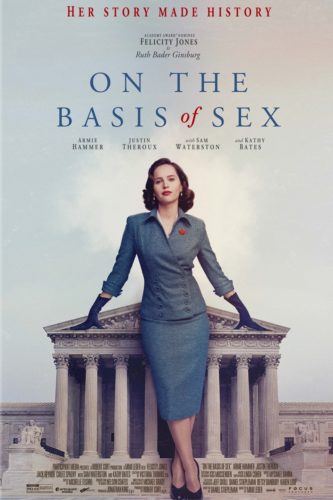
I’ll say this for ON THE BASIS OF SEX, the latest in a long line of shameless Oscar-grabbers that appeared in ‘18: it’s quite watchable. It dramatizes the early years of liberal superstar Ruth Bader Ginsburg, who’s presented as a passionate, intelligent, gorgeous and tireless crusader whose only flaw is that she cares too much. As in most reality-based Oscar baiters, this quintessentially American character is played by a Brit: Felicity Jones, who does reasonably well in the role. Director Mimi Leder hits all the expected notes in what one critic accurately described as a “love letter” to RBG, who as portrayed here can literally do no wrong. For that reason there’s not much in the way of drama or suspense, with RBG’s family problems and courtroom battles both guaranteed to work out in her favor, and she destined to become the Greatest Woman who Ever Lived.
10. DESTROYER
Artier-than-average police movie stuff from director Karyn Kusama, who previously struck out with AEON FLUX and JENNIFER’S BODY. DESTROYER isn’t quite as awful, but still misses its target, being labored and self-important to a fault. It stars an unrecognizable Nicole Kidman (who struggles throughout to disguise her Australian accent) as a burned-out LAPD detective attempting to reconnect with an undercover case from years earlier that went horrifically wrong. Kusama deserves points for never sugarcoating her heroine’s abrasiveness, or attempting to turn her into some kind of feminist icon (as tends to be the case with woman-centered crime dramas), with Kidman appearing falling-down-drunk, jerking off a suspect and puking on another’s floor. With a less affected treatment this may have wound up a legitimately good movie, and not merely an extended awards reel for Kidman, which right now is all DESTROYER really is.
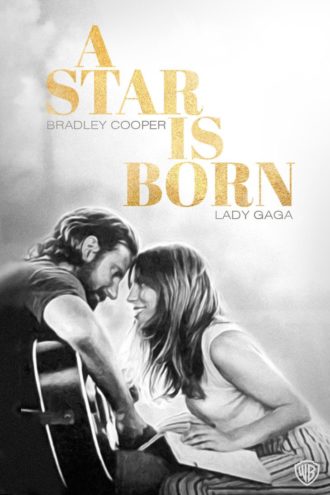 11. A STAR IS BORN
11. A STAR IS BORN
Here an oft-filmed tale is given an extremely slick modern redo, which fails to disguise the fact that the material is quite tired. Bradley Cooper was the writer, director and lead actor, and does superlative work in all three areas. So does Lady Gaga as the titular star, a young woman plucked out of obscurity by country music star Cooper. Gaga’s rise to the top of the pop music heap seems remarkably easy, but Cooper’s mood swings and addictions threaten to doom both of them. Cooper modernizes this moldy account in every way he can—most notably in the supporting cast, which is made up largely of non-white and LGBTQ performers—but it’s all for naught, as the whole film, despite its burnished visuals, has a shopworn feel. It certainly doesn’t help matters that the copious pop tunes crooned by Lady G. are instantly and totally forgettable.
12. JURASSIC WORLD: FALLEN KINGDOM
This latest installment in the JURASSIC franchise provides more of the same, namely a bunch of people getting chased around by dinosaurs and a heavy-handed message about the consequences of tampering with the natural order of things (presented here as an obvious climate change metaphor). Bryce Dallas Howard and Chris Pratt are back from the previous JURASSIC flick, joined by Toby Jones as a slimeball who genetically engineers a new super-dinosaur and a number of other interchangeable performers; as always with these films, it’s the CGI dinosaurs who make the greatest impression acting-wise. Director J.A. Bayona doesn’t seem too inspired, providing a succession of repetitive action sequences that might have played better if they weren’t so similar to the many like-minded scenes contained in the previous JURASSIC flicks.
13. BOHEMIAN RHAPSODY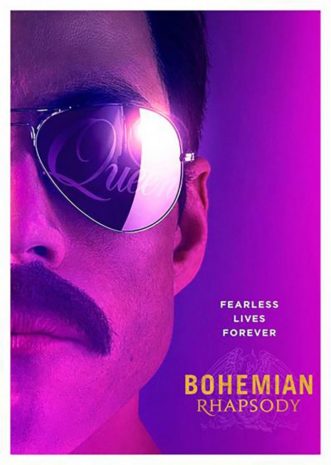
A biopic of Queen’s Freddy Mercury, so you can be sure that at the very least the music is good. I’ll also praise the lead performance of Rami Malek, who from what we’re shown here would appear to have a more varied and charismatic stage presence than the actual Freddy Mercury. The movie, alas, is standard Hollywood rock biopic fluff. If you’ve seen THE ROSE, ELVIS, THE DOORS or a dozen or so other rock movies you’ll know what to expect: an idealistic young singer joins a band, becomes a star and unleashes his self-destructive proclivities in the form of drugs and bad behavior. He eventually cleans up his act, but only after learning he has AIDS, and attains his apotheosis at Live Aid in 1985. The latter sequence, in which Malek and his co-stars enact several classic Queen tunes for an adoring crowd, is easily the best part of the entire film—which certainly doesn’t say much for the rest of it!
14. THE 15:17 TO PARIS
This film isn’t as bad as so many critics claimed, although it is decidedly problematic. A dramatization of the events of August 21, 2015, when three American men, two of them soldiers, foiled a terrorist attack aboard a train to Paris, it’s certainly an oddity among 2018’s line-up of liberal-minded releases in its staunchly masculine, pro-military stance. Producer-director Clint Eastwood further bucks tradition by having the actual guys involved in the incident play themselves (with the more seasoned performers Jena Fisher and Judy Greer playing the guys’ moms), and actually uses their non-acting to the film’s advantage, imparting an appealingly loose, naturalistic vibe that none of Eastwood’s other movies have. The problem is with the account itself, which just isn’t meaty enough to fill out a feature film. Certainly these mens’ actions were heroic, and are well staged by Eastwood, but I’m not sure we needed the lengthy childhood flashbacks, or the dull scenes of the guys schlepping around Europe while one of them speaks of his conviction that they’re destined for some Momentous Act.
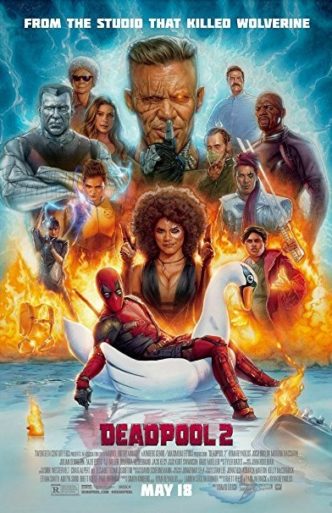 15. DEADPOOL 2
15. DEADPOOL 2
This DEADPOOL sequel contains just enough of the irreverent swagger and raunchy humor of the former film—for its first half, at least. After that, alas, it descends into nonsense. The material is, obviously, quite wild and untamed, yet the previous film’s director Tim Miller was able to maintain control from start to raucous finish. That’s not the case here, with replacement helmer David Leitch utilizing a far less steady hand. Ryan Reynolds is once again featured as an undead smartass tearing up the streets of Vancouver and constantly getting killed and/or mutilated horrifically—a joke that, like virtually everything else in this movie, is vastly overused. Morena Baccarin returns as his love interest, who is killed off, leading to a lot of tone-breaking sap that doesn’t sit well with Deadpool’s irreverent antics. Also on hand is Josh Brolin, leading a cadre of new characters who only serve to overburden an already overburdened film. The copious CGI-enhanced action scenes are well handled and plenty brutal, but—once again—they’re subjected to the “more is more” mentality that suffuses this movie, and so eventually lose their power.
16. A SIMPLE FAVOR
A very watchable thriller, and no wonder: it’s headlined by Anna Kendrick and Blake Lively, both of whom are mighty easy on the eyes. As for the plot in which they find themselves enmeshed, it’s essentially a cross between SINGLE WHITE FEMALE and GONE GIRL, with Kendrick as a mousey mommy vlogger befriending a glamorous society gal (Lively) who disappears after leaving Kendrick to look after her child. After a few days it transpires that Lively has been drowned, and Kendrick happily assumes her life, raiding her wardrobe and sleeping with her hunky husband (Henry Golding). But is Lively really dead? And is Kendrick, whose own husband died years earlier in a suspicious car accident, really as innocent as she seems? Lotsa twists are in store, and not a few clichés (such as the age-old device of one of the principals having a heretofore unknown twin sibling), and the whole thing grows increasingly silly and uninvolving.
17. MIND GAME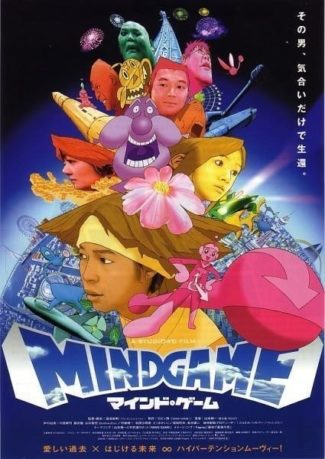
A well-regarded anime feature that premiered back in 2004 yet didn’t receive US distribution until 2018. Better late than never, I guess, although I’m not entirely sold on the film. Based on a manga by Robin Nishi, MIND GAME is about a character named, appropriately enough, Robin Nishi, an aspiring manga artist whose girlfriend has just left him. Drowning his sorrows in a local bar, Nishi finds himself caught up a mob shoot-out, during which he’s killed–and plunged into a hallucinatory reality in which he’s forced to take stock of his uneventful life. All of this is gorgeously designed and executed in contrasting animation styles that range from photorealistic to surreal and expressionistic, often in direct imitation of popular anime tropes. Add to that the frequently outré visual compositions and an evident love of esoteric detail (such as a tiny robot who appears on a character’s shoulder, and is given a number of pertinent close-ups despite having no direct bearing on the action), and you’ve got a film that may well contain too much assorted weirdness. Innovative and visually rapturous MIND GAME is, but involving and cohesive it definitely isn’t.
18. SUSPIRIA
Every year, it seems, brings at least one ridiculously pretentious abomination like this film. It’s an ersatz remake of Dario Argento’s SUSPIRIA, but outside the overall premise, about a 1970s-era witch-infested dance academy whose pupils have an unfortunate habit of being killed in various elaborate ways, this SUSPIRIA has little in common with Argento’s. It features Dakota Johnson as a winsome Amish gal who enters the academy and immediately catches the eye of one of the headmistresses (Tilda Swinton). Johnson is captivating enough that there’s a noticeable void whenever she’s not onscreen (which is often), despite the fact that the supporting cast is made up of skilled players like THE TIN DRUM’S Angela Winkler, THE FOURTH MAN’S Renée Soutendijk and Jessica Harper from the original SUSPIRIA. The problem is that director Luca Guadagnino has concocted a nonsensical jumble of a narrative that makes little sense. That’s despite a heavy political angle in the form of the Baader Meinhof group that terrorized Germany in the seventies, and a sappy subplot involving an elderly holocaust survivor that appears to have been intended to offset the horror. The film’s main interest is in its visuals, which are wildly baroque and overwrought. Guadagnino never misses a chance to shoot a scene through distorted glass or a gaudily colored filter, and makes sure to intercut the murder scenes with footage of Johnson dancing. He also encourages his performers to overact shamelessly, and goes completely over the top in the ludicrous climax, which tries to outdo Argento’s fabled gory set-pieces in a riot of exploding heads and spurting blood. The ultimate effect, however, is one of exasperation, especially given that the climax in question occurs near the end of a vastly inflated 2½ hour-plus runtime.
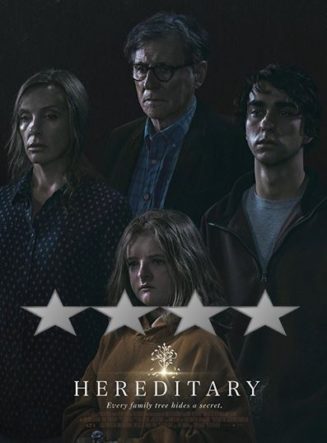 19. HEREDITARY
19. HEREDITARY
Inexplicably enough, this was one of the year’s biggest horror hits. The debut film of writer-director Ari Aster, it pivots on a memorably histrionic performance by Toni Collette, who, in concert with the rest of the cast, seems determined to outdo Nicolas Cage in over-the-top emoting. She plays a woman who as the film opens has just lost her mother, and shortly thereafter will lose her young daughter in a car accident that leaves the kid decapitated (Aster’s decidedly unsubtle touch is indicated by a close-up he provides of the errant head on the ground). It seems there’s a curse on the family that causes naked ghost people to turn up throughout the house, along with frisky invisible men and freaky dreams involving people’s heads turning into basket balls, all pitched at a level of Ken Russell-esque outrage that matches the performances. Such an approach can certainly be fun, and often is, but the lack of narrative cohesion ultimately does the film in.
20. SOLO
This, the latest standalone STAR WARS entry, is entertaining enough, but also curiously unmemorable. It’s hard to tell if the problem is with the direction by Ron Howard and the script by Lawrence and Jonathan Kasdan, or the fact that the material has simply gotten old (especially given that Disney has been cranking STAR WARS movies out with such numbing regularity). It stars Alden Ehrenreich as a young Han Solo who looks and acts nothing like Harrison Ford, caught up in a drama that involves planet hopping, derring-do and a curiously limp ending. Along for the ride are the expected succession of familiar supporting players (unlike the original STAR WARS trilogy, whose cast members were deliberately chosen to not be recognizable): Woody Harrelson, Donald Glover (who’s actually quite strong as a young Lando Calrissian), Thandie Newton, Paul Bettany and Emilia Clarke (in the by-now requisite brunette British cutie role).
Still Waiting On…
2.0
The long-awaited sequel to 2010’s Lollywood wonder ROBOT that’s already wowed audiences in its native India.
BENEDETTA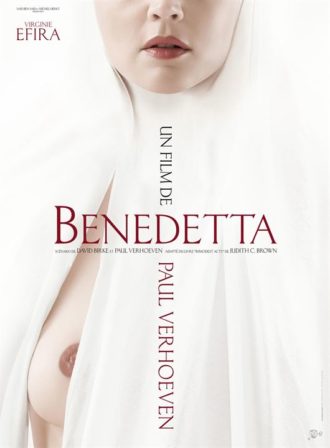
A historical drama about a lesbian nun—i.e. an arty nunsploitation movie—by Paul Verhoeven, who definitely seems the right guy to direct this sort of fare.
CINEMA PERVERSO: THE WONDERFUL AND TWISTED WORLD OF RAILROAD CINEMAS
A three year old documentary on trash cinema in Germany that’s funny, revelatory and entertaining—and should find favor with American trash movie mavens.
CLIMAX
Were this Gaspar Noe freak-out released in 2018 it would have easily made my #1 pick. It’s a mindblower that simply must be experienced, preferably on a big screen!
HAGAZUSSA: A HEATHEN’S CURSE
A medieval-set art-horror stunner from Austria that’s everything THE WITCH should have been.
INSECT
The latest and apparently last feature by the incomparable Jan Svankmajor. Not his best work, but again, it’s a Svankmajor film, and so required viewing for all readers of this site.
THE IRISHMAN
A much-delayed Martin Scorsese directed, Robert De Niro headlined crime epic that promises to be one of Netflix’s most auspicious releases—if, that is, the damn thing ever gets finished!
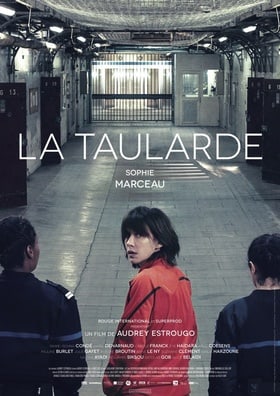 JAILBIRDS (LA TAULARDE)
JAILBIRDS (LA TAULARDE)
Another film that’s taken an ungodly long time to make its way to these shores, a wrenching 2015 French-made prison drama starring a never-better Sophie Marceau.
MISS BALA
Of the many female revenge movies set to hit theaters in ‘19, I say this Gina Rodriguez starrer, a remake of the similarly titled Mexican thriller from 2011, looks the most promising.
ONCE UPON A TIME IN HOLLYWOOD
Quentin Tarantino takes on the Manson murders, along with Brad Pitt, Leonardo DiCaprio, Margot Robbie, Al Pacino and quite few other big names. The curiosity factor alone, I’d say, renders this one a must see.
SIBERIA
A long-in-the-works Abel Ferrara project that’s said to be a loose adaptation of Carl Jung’s RED BOOK starring William Dafoe. Announced back in 2015, I’m not exactly holding my breath for this film to reach fruition, but will be there if and when it finally turns up.
THE WOLF HOUSE
This Chilean oddity is the state of the art in modern animation filmmaking, a twisted, bizarre and consistently impressive piece of work that demands to be discovered and enjoyed by all weird movie buffs.
